Abstract
Sepsis and trauma result in increases in epinephrine, glucagon, and cortisol secretion as well as alterations in respiratory pattern that is characterized by increased minute ventilation, decreased tidal volume, and increased frequency. Six male subjects were infused for 5.5 hours with cortisol, epinephrine, and glucagon in amounts designed to simulate plasma levels seen in patients following trauma. During the initial 20 minutes of the hormone infusion, minute ventilation (VE), oxygen consumption (VO2), and carbon dioxide production (VCO2) increased above preinfusion values. VCO2 increased more than VO2 resulting in an increase in respiratory quotient (RQ) from 0.93 to 1.14. The increase in VE was due to increased tidal volume and not frequency (f). After 4.5 hours, the VE, VO2, and VCO2 were still above preinfusion levels but the RQ had decreased to 0.98 because of a decrease in VCO2. Frequency had increased from 19 +/- 4.8 breaths/min preinfusion to 22 +/- 4.7 after 4.5 hours. After 4.5 hours, VT was still above preinfusion levels while pH and PaCO2 had decreased below them. The latter was associated with an increase in serum lactate. At no time was a decrease in tidal volume observed. Therefore, the infusion of these hormones does not simulate all the alterations observed during trauma and sepsis.
Full text
PDF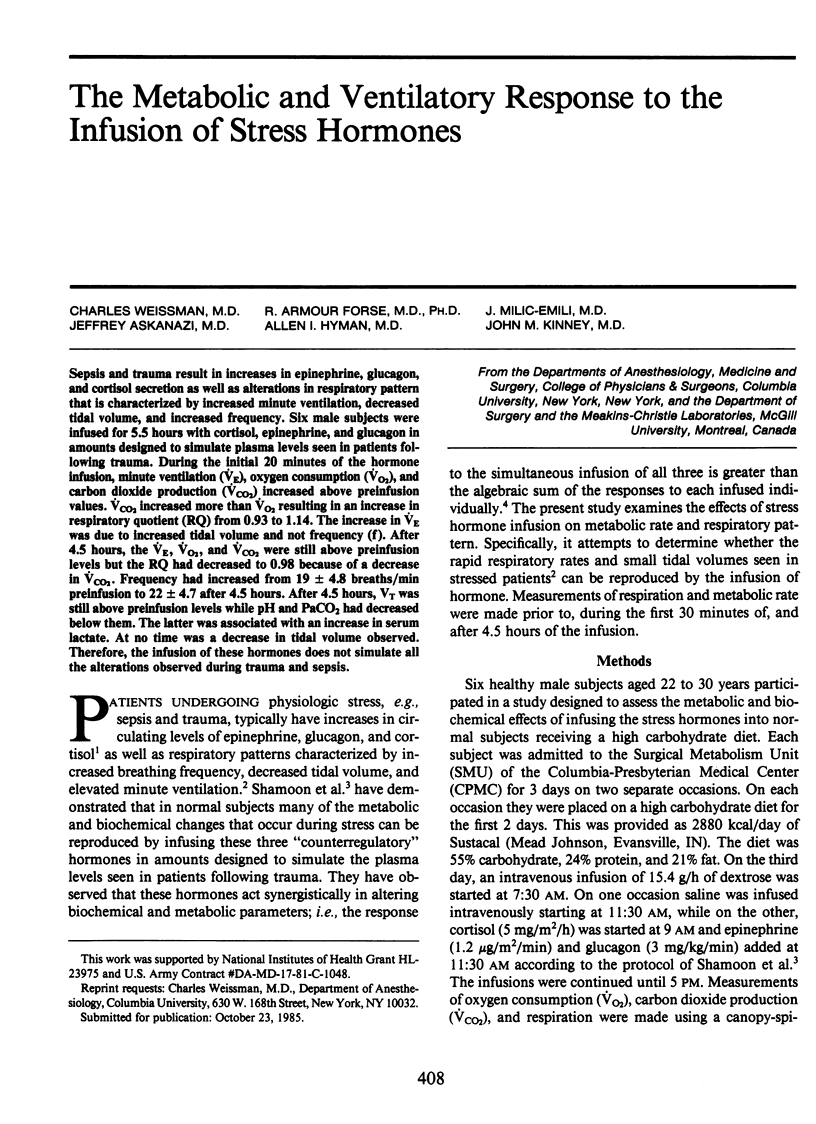
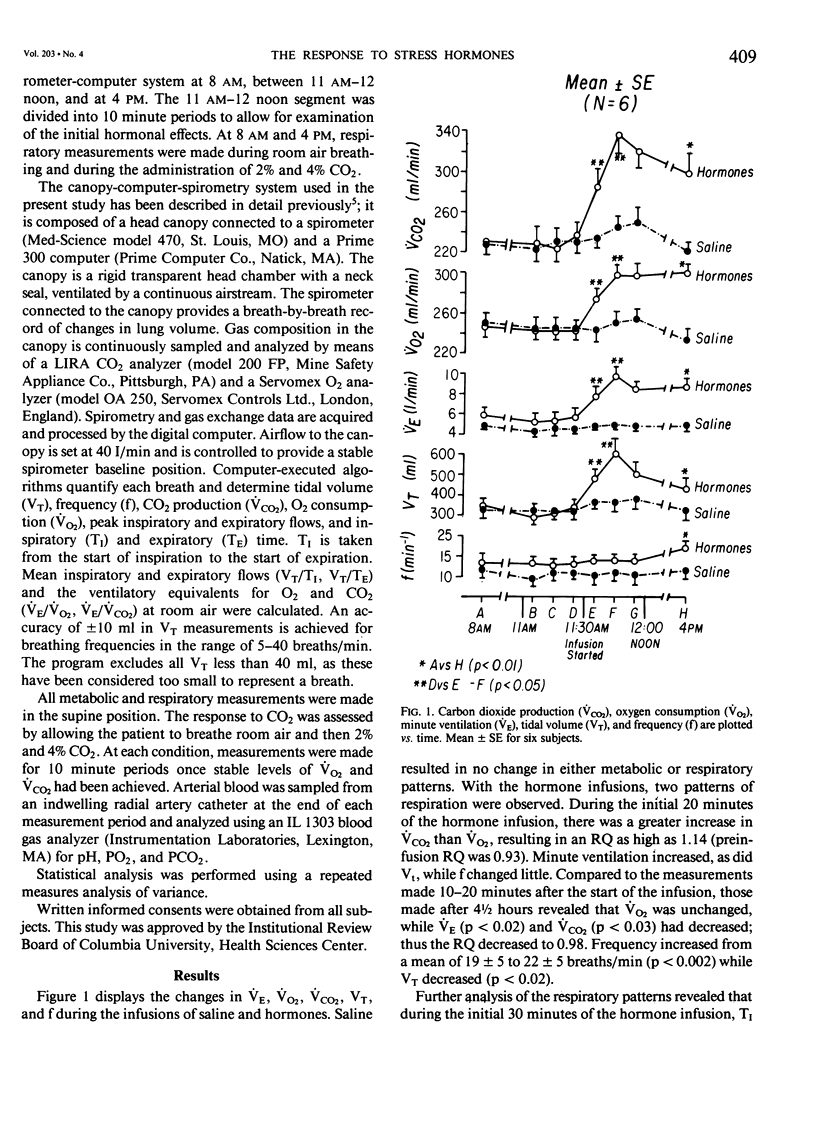
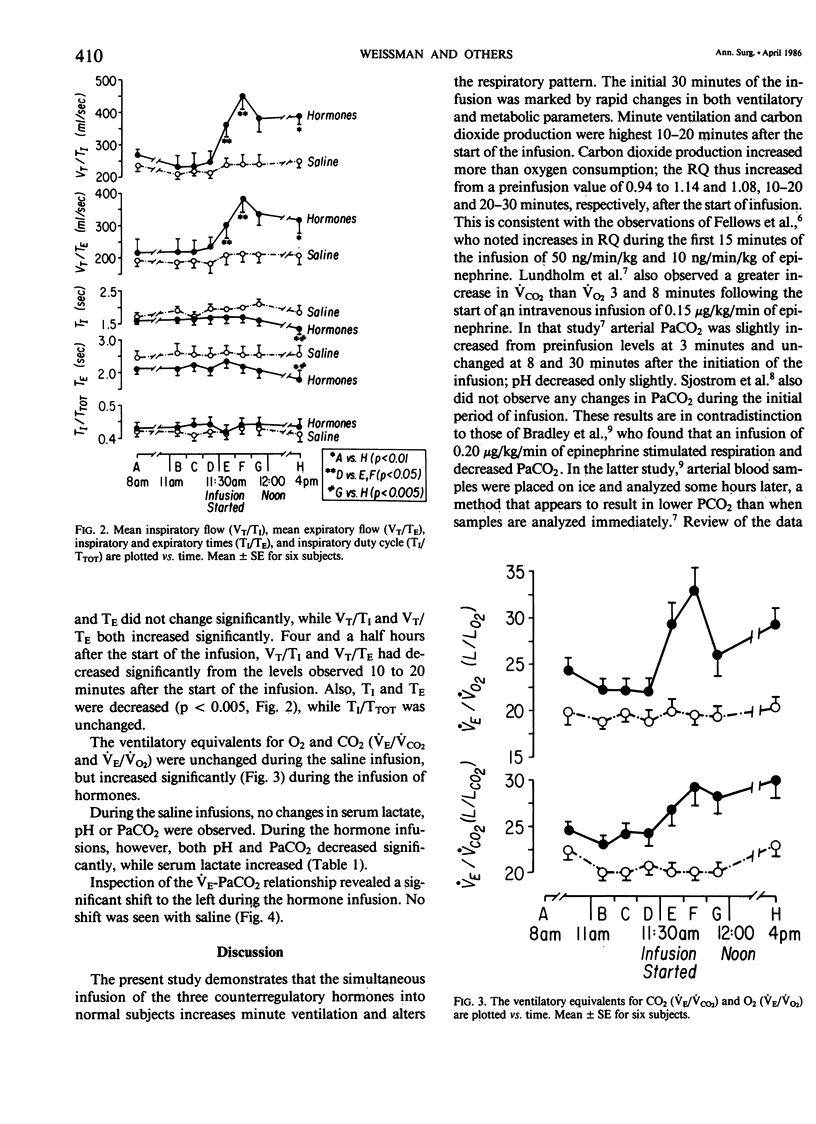
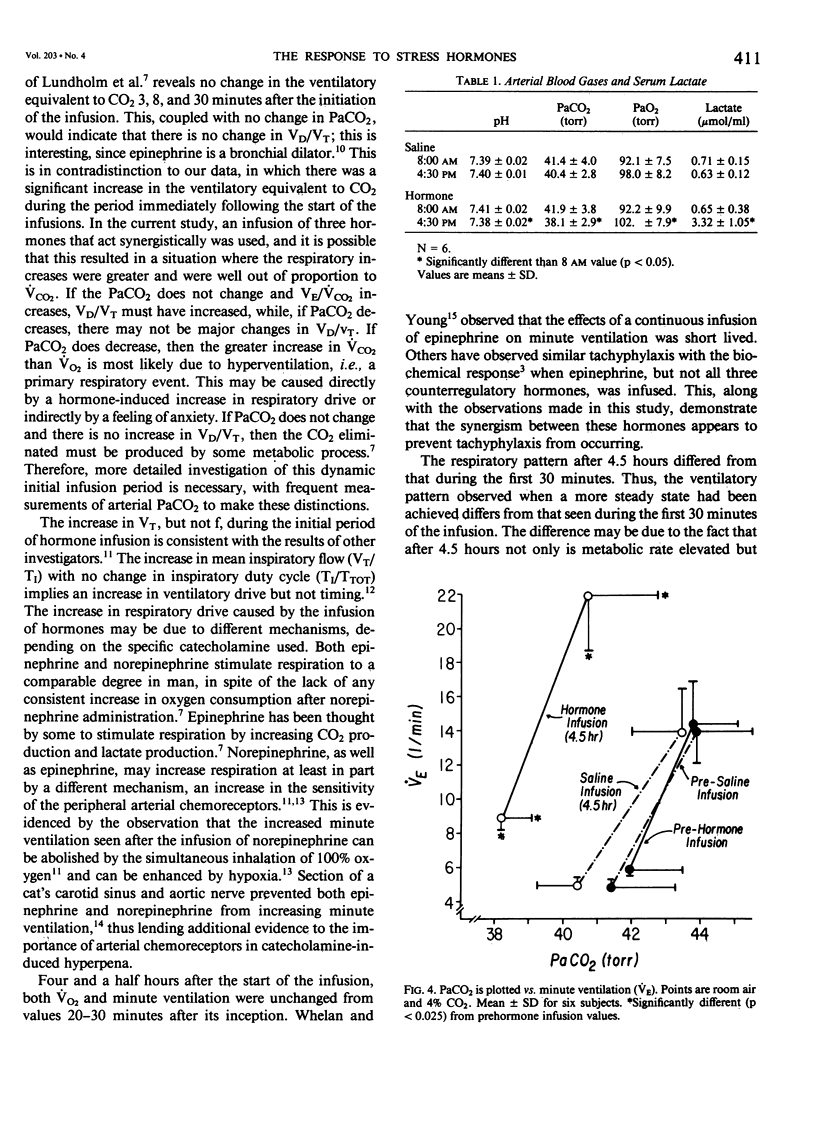
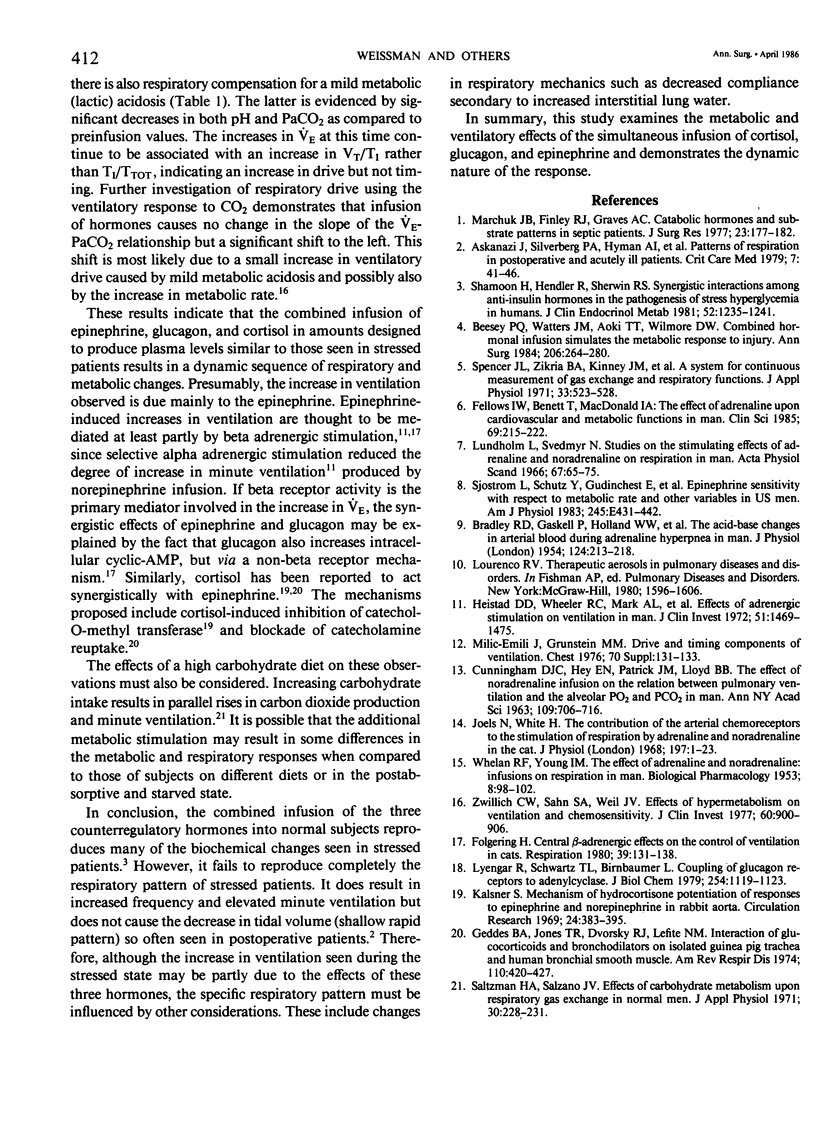
Selected References
These references are in PubMed. This may not be the complete list of references from this article.
- Askanazi J., Silverberg P. A., Hyman A. I., Rosenbaum S. H., Foster R., Kinney J. M. Patterns of ventilation in postoperative and acutely ill patients. Crit Care Med. 1979 Feb;7(2):41–46. doi: 10.1097/00003246-197902000-00002. [DOI] [PubMed] [Google Scholar]
- BRADLEY R. D., GASKELL P., HOLLAND W. W., DE LEE G. J., YOUNG I. M. The acid-base changes in arterial blood during adrenaline hyperpnoea in man. J Physiol. 1954 May 28;124(2):213–218. doi: 10.1113/jphysiol.1954.sp005100. [DOI] [PMC free article] [PubMed] [Google Scholar]
- Bessey P. Q., Watters J. M., Aoki T. T., Wilmore D. W. Combined hormonal infusion simulates the metabolic response to injury. Ann Surg. 1984 Sep;200(3):264–281. doi: 10.1097/00000658-198409000-00004. [DOI] [PMC free article] [PubMed] [Google Scholar]
- Fellows I. W., Bennett T., MacDonald I. A. The effect of adrenaline upon cardiovascular and metabolic functions in man. Clin Sci (Lond) 1985 Aug;69(2):215–222. doi: 10.1042/cs0690215. [DOI] [PubMed] [Google Scholar]
- Folgering H. Central beta-adrenergic effects on the control of ventilation in cats. Respiration. 1980;39(3):131–138. doi: 10.1159/000194207. [DOI] [PubMed] [Google Scholar]
- Geddes B. A., Jones T. R., Dvorsky R. J., Lefcoe N. M. Interaction of glucocorticoids and bronchodilators on isolated guinea pig tracheal and human bronchial smooth muscle. Am Rev Respir Dis. 1974 Oct;110(4):420–427. doi: 10.1164/arrd.1974.110.4.420. [DOI] [PubMed] [Google Scholar]
- Heistad D. D., Wheeler R. C., Mark A. L., Schmid P. G., Abboud F. M. Effects of adrenergic stimulation on ventilation in man. J Clin Invest. 1972 Jun;51(6):1469–1475. doi: 10.1172/JCI106943. [DOI] [PMC free article] [PubMed] [Google Scholar]
- Iyengar R., Swartz T. L., Birnbaumer L. Coupling of glucagon receptor to adenylyl cyclase. Requirement of a receptor-related guanyl nucleotide binding site for coupling of receptor to the enzyme. J Biol Chem. 1979 Feb 25;254(4):1119–1123. [PubMed] [Google Scholar]
- Joels N., White H. The contribution of the arterial chemoreceptors to the stimulation of respiration by adrenaline and noradrenaline in the cat. J Physiol. 1968 Jul;197(1):1–23. doi: 10.1113/jphysiol.1968.sp008541. [DOI] [PMC free article] [PubMed] [Google Scholar]
- Kalsner S. Mechanism of hydrocortisone potentiation of responses to epinephrine and norepinephrine in rabbit aorta. Circ Res. 1969 Mar;24(3):383–395. doi: 10.1161/01.res.24.3.383. [DOI] [PubMed] [Google Scholar]
- Lundholm L., Svedmyr N. Studies on the stimulating effects of adrenaline and noradrenaline on respiration in man. Acta Physiol Scand. 1966 May;67(1):65–75. doi: 10.1111/j.1748-1716.1966.tb03288.x. [DOI] [PubMed] [Google Scholar]
- Marchuk J. B., Finley R. J., Groves A. C., Wolfe L. I., Holliday R. L., Duff J. H. Catabolic hormones and substrate patterns in septic patients. J Surg Res. 1977 Sep;23(3):177–182. doi: 10.1016/0022-4804(77)90018-x. [DOI] [PubMed] [Google Scholar]
- Milic-Emili J., Grunstein M. M. Drive and timing components of ventilation. Chest. 1976 Jul;70(1 Suppl):131–133. doi: 10.1378/chest.70.1_supplement.131. [DOI] [PubMed] [Google Scholar]
- Saltzman H. A., Salzano J. V. Effects of carbohydrate metabolism upon respiratory gas exchange in normal men. J Appl Physiol. 1971 Feb;30(2):228–231. doi: 10.1152/jappl.1971.30.2.228. [DOI] [PubMed] [Google Scholar]
- Shamoon H., Hendler R., Sherwin R. S. Synergistic interactions among antiinsulin hormones in the pathogenesis of stress hyperglycemia in humans. J Clin Endocrinol Metab. 1981 Jun;52(6):1235–1241. doi: 10.1210/jcem-52-6-1235. [DOI] [PubMed] [Google Scholar]
- Sjöström L., Schutz Y., Gudinchet F., Hegnell L., Pittet P. G., Jéquier E. Epinephrine sensitivity with respect to metabolic rate and other variables in women. Am J Physiol. 1983 Nov;245(5 Pt 1):E431–E442. doi: 10.1152/ajpendo.1983.245.5.E431. [DOI] [PubMed] [Google Scholar]
- Spencer J. L., Zikria B. A., Kinney J. M., Broell J. R., Michailoff T. M., Lee A. B. A system for continuous measurement of gas exchange and respiratory functions. J Appl Physiol. 1972 Oct;33(4):523–528. doi: 10.1152/jappl.1972.33.4.523. [DOI] [PubMed] [Google Scholar]
- WHELAN R. F., YOUNG I. M. The effect of adrenaline and noradrenaline infusions on respiration in man. Br J Pharmacol Chemother. 1953 Mar;8(1):98–102. doi: 10.1111/j.1476-5381.1953.tb00759.x. [DOI] [PMC free article] [PubMed] [Google Scholar]
- Zwillich C. W., Sahn S. A., Weil J. V. Effects of hypermetabolism on ventilation and chemosensitivity. J Clin Invest. 1977 Oct;60(4):900–906. doi: 10.1172/JCI108844. [DOI] [PMC free article] [PubMed] [Google Scholar]


